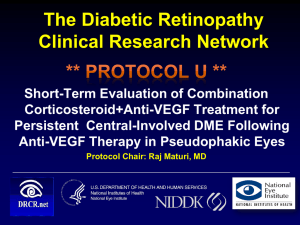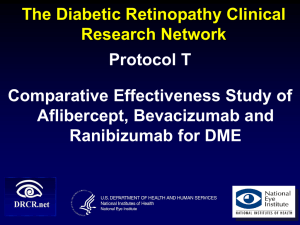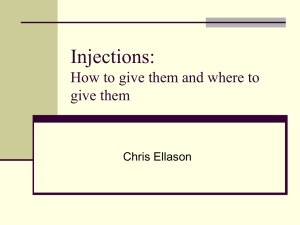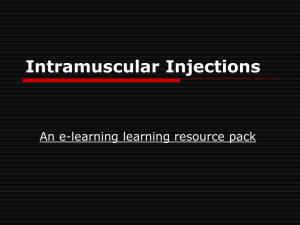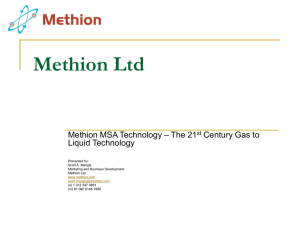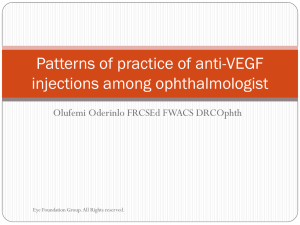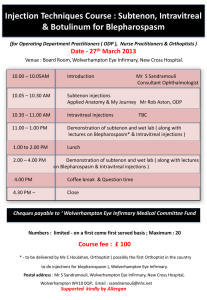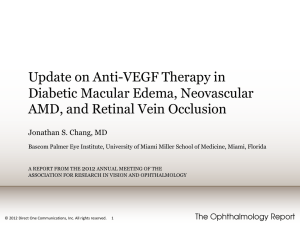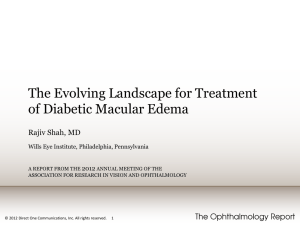The Diabetic Retinopathy Clinical Research Network
advertisement
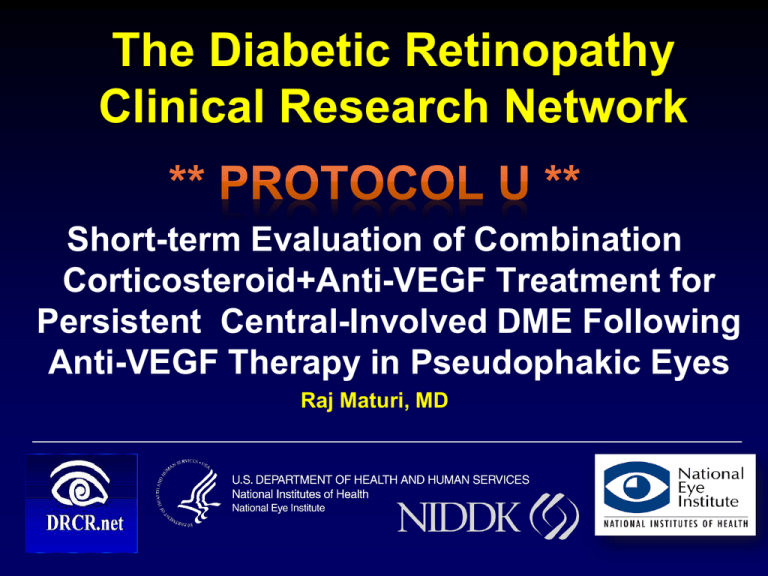
The Diabetic Retinopathy Clinical Research Network Short-term Evaluation of Combination Corticosteroid+Anti-VEGF Treatment for Persistent Central-Involved DME Following Anti-VEGF Therapy in Pseudophakic Eyes Raj Maturi, MD 1 Background: The Problem 52% of Protocol I ranibizumab eyes didn’t achieve ≥2 vision-line improvement, and more than 40% did not have resolution of retinal thickening (<250 µm) at year 2. Protocol I data suggest that eyes that remain edematous at 6 months and 1 year following ranibizumab treatment have been consistently thickened throughout the treatment period. 21% percent of ranibizumab eyes still had retinal thickness ≥ 300 μm, with vision of 20/32 or worse at 1 year. • 39% had persistent CST ≥300 μm during year 1 2 Studies have shown the benefits of intravitreal steroids for DME Protocol I, pseudophakic subgroup had a visual gain similar to the Ranibizumab treated groups FAME study of intravitreal fluocinolone demonstrated benefits over 3 years MEAD study results show benefit of Ozurdex over three year treatment period Cataracts and IOP rise are issues Dexamethasone May Help Study Design Dutra, Ophthalmologica 2013 Retrospect. Review Pacella, Clin Ophthalmol. 2013 Single center uncontrolled prospective study Zucchiatti, Ophthalmologica 2012 Retrospec. interventional study Maturi, et al. 2013 ASRS talk (submitted, 2014) Prospective controlled # Eyes 58 20 9 40 Setting Summary Decrease in foveal “Refractory” thickness and DME increase in VA at 3 and 6 mo. DME ≥275 μm with “previous” anti-VEGF Improve in ret. thickness and VA 1-3 months then decline through 6 months Improvement in VA “Persistent” and ret. Thickness DME maintained through 4th month DME – 88% with previous Avastin Edema much less in combo group. 4 Rationale There is a need for alternative or additional treatments due to incomplete response to ranibizumab in about ½ the eyes. Protocol I data showed that the pseudophakic subgroup achieved the same results as ranibizumab at 2 yrs (this was not a prespecified subgroup, however). As intravitreal steroids have been shown to have a positive effect on DME in some eyes, despite safety issues, and might add benefit in eyes that are already receiving anti-VEGF, where benefits might outweigh risks. 5 Objectives To assess short-term effects of combination steroid+anti-VEGF therapy on OCT retinal thickness and visual acuity in comparison with that of continued anti-VEGF therapy alone in pseudophakic eyes with persistent DME and visual acuity impairment despite previous antiVEGF treatment. To provide more information needed for future conduct of a definitive phase III clinical trial. 6 Rationale for a Phase II Trial Currently, there are limited data on combination steroid+anti-VEGF injections for DME A large treatment effect on pseudophakic eyes is needed before considering combination therapy as a long-term treatment in eyes at risk for development of cataract Before embarking on a phase III study, we need: • To determine whether the conduct of a phase III trial has merit based on anatomic and functional outcomes • To estimate recruitment potential of a phase III trial • To assess safety of combination steroid+anti-VEGF in eyes with persistent DME, removing confounding of cataract and cataract surgery 7 Study Drugs Dexamethasone (OZURDEX®) Sustained-release biodegradable polymer matrix that provides 700 μg of preservative-free dexamethasone FDA-approved for noninfectious post. uveitis and macular edema due to retinal vein occlusion Provided by Allergan Inc. Ranibizumab 0.3mg (LUCENTIS®) Anti-human VEGF monoclonal antibody FDA-approved for treatment of wet AMD, macular edema following RVO, and DME Provided by Genentech Inc. 8 Dexamethasone Decreases inflammation by suppression of neutrophil migration, decreased production of inflammatory mediators, and reversal of increased capillary permeability, and suppresses normal immune response* Onset of action* • BRVO/CRVO: Improvement observed in 20% to 30% of patients within first 2 months following intravitreal injection Duration of effect* • BRVO/CRVO: 1-3 months (following onset of improvement) Absorption* • Systemic levels negligible in majority of patients ≤90 days following implant * AccessPharmacy: McGraw-Hill Global Education 9 Dexamethasone Size: 0.45 mm in diameter, and 6.5 mm in length Administered through a single-use 22 gauge injection system Common adverse events include*: • • • • • Cataract (nuclear, cortical, PSC) (22%) Conjunctival hemorrhage (21%), Increased IOP (15%) Reduced VA (10%) Vitreous hemorrhage (10%) Rare reported adverse events • Migration to ant. chamber • Endophthalmitis DRCR.net investigators’ experience • 88% have performed Dex. implant in clinical practice; of the 12% who haven't, 75% have performed a training Dex implant (pig or cadaver eye) * Callanan et al; Ozurdex PLACID Study Group: Ophthalmology May 2012 10 METHODS 11 Study Design Phase II, multicenter, controlled, participant-masked, clinical trial Duration of Follow-up Run-in Phase 12 Weeks Purpose To ensure that enrolled eyes truly have “persistent DME” with decreased visual acuity despite prior anti-VEGF therapy. Randomized Phase 24 Weeks 12 Study Overview SHM SHM VGF VGF Week 0 VGF Week 4 VGF Week 8 VGF Week 12 VGF Week 16 Week 20 Week 24 Group A: Sham + Ranibizumab VGF VGF Week 0 Week 4 VGF Week 8 Week 12 Group B: Dexamethasone+ Ranibizumab Enrollment Week 0 VGF Dex Run-In Phase (3 months) Assess Eligibility For Randomization Week 4 VGF Week 8 VGF Week 12 VGF Week 16 VGF Week 20 Week 24 VGF Dex Randomization Phase (6 months) 13 Study Eye Both eyes can be enrolled if eligible for the run-in phase Both eyes can be randomized if criteria met for randomization Two eyes from the same participant will be randomized to different treatment arms 14 Study Sample Size A minimum of 75 study eyes in each group (from approximately 62 participants) 15 Major Eligibility Criteria Age ≥18 years Type 1 or type 2 diabetes At least 1 eye meeting study eye eligibility criteria No history of chronic renal failure requiring dialysis or kidney transplant BP <180/110 No history of cardiac event or stroke within 1 month prior to enrollment 16 Major Study Eye Eligibility Criteria Pseudophakic At least 6 injections of anti-VEGF drugs (aflibercept, bevacizumab, or ranibizumab) within the prior 36 weeks (9 months) Visual acuity letter score ≤78 and ≥24 (20/32 to 20/320) Central-involved DME on clinical exam OCT CSF thickness within 8 days of enrollment ≥340 on Zeiss Cirrus ≥360 on Zeiss Stratus No macular laser or PRP within 4 months or anticipated need for PRP in next 6 months No previous history of glaucoma or steroid intraocular pressure response in either eye 17 Other Study Eye Exclusion Criteria Substantial posterior capsule opacity likely to be decreasing visual acuity by 3 lines or more History of major ocular surgery within 4 months of enrollment or anticipated within 6 in study, or any history of vitrectomy History of cataract extraction within 6 months or YAG capsulotomy within 2 mo prior to enrollment IOP ≥25 mmHg or history of open angle glaucoma History of herpetic ocular infection Sutured PC-IOL with ruptured post. capsule Exam evidence of toxoplasmosis or pseudoexfoliation 18 Non-Study Eye Criteria In subjects with only one study eye, the following must be met in the fellow non-study eye: • IOP <25 mm Hg • No history of open-angle glaucoma • No history of steroid-induced IOP elevation that required IOP-lowering treatment • No exam evidence of pseudoexfoliation 19 Enrollment Testing Procedures E-ETDRS visual acuity testing at 3 meters in each eye • within 8 days prior to enrollment • Includes protocol refraction prior to VA testing OCT on study eye • within 8 days prior to enrollment and at least 21 days after any prior intravitreal anti-VEGF treatment Ocular examination on each eye • including slit lamp, measurement of intraocular pressure, lens assessment, and dilated ophthalmoscopy (within 8 days prior to enrollment) Measurement of blood pressure 20 Overview Run-In Phase • All enrolled eyes are required to complete a 12-week runin phase, where they receive 3 additional anti-VEGF injections Objective • To ensure that enrolled eyes truly have “persistent DME” despite prior anti-VEGF therapy when given up to 3 injections within the controlled environment of a study Visit Schedule • 4 weeks (±1 week) • 8 weeks (±1 week) • 12 weeks (±1 week) – Randomization visit A minimum of 21 days required between visits 21 Run-in Phase Visits (4 and 8-week visit) Procedures E-ETDRS visual acuity testing in each eye, including protocol refraction in the study eye OCT on study eye Ocular examination on study eye • including slit lamp, measurement of intraocular pressure, lens assessment, and dilated ophthalmoscopy 22 Treatment During Run-in Phase All study eyes will receive an injection of ranibizumab 0.3 mg at enrollment, 4 weeks, and 8 weeks. Injections must be at least 21 days apart. If an eye experienced adverse effects from a prior injection during the run-in phase precluding future injections or additional injections are otherwise contraindicated according to the investigator (e.g. DME is no longer present), the eye will not continue in the study 23 Randomization At end of run-in phase, study eye(s) are randomized if: • All 3 run-in visits and injections completed within ±10 days of the target visit date o website will force completion of final status form if, at any run-in visit, the participant comes in past the allowable window or the injection is missed • Randomization visit is no more than 5 weeks from 8week visit • Has been ≥21 days since prior study injection • VA letter score ≤78 and ≥24 (20/32 to 20/320) • Definite central-involved DME on clinical exam • Definition of “persistent DME” is met • Confirmation that no exclusion criteria for enrollment have developed/occurred during run-in phase If above are not met, study eyes exit the study 24 Persistent DME at End of Run-in Phase CSF thickness on OCT meeting either one of the following two criteria: • 1) ≥ 440 µm Zeiss Cirrus OR ≥ 460 µm on Heidelberg Spectralis OR • 2) Zeiss Cirrus [340 - 439 μm] or Heidelberg Spectralis [360 - 459 μm] AND has not decreased from the prior (8-week) visit by 10% or more 25 Randomization Visit Procedures E-ETDRS visual acuity (including protocol refraction) in each eye on day of randomization OCT on study eye (on day of randomization) Ocular examination on each eye • including slit lamp, measurement of intraocular pressure, lens assessment, and dilated ophthalmoscopy (on day of randomization) HbA1c Measurement of blood pressure 26 Study Treatment Groups Participants with one study eye • Group A: Sham + intravitreal ranibizumab • Group B: Intravitreal dexamethasone + intravitreal ranibizumab Participants with two study eyes (both eyes are eligible at the time of randomization): • One eye randomly receives Group A, and the other eye receives Group B Randomization will be stratified by VA and OCT CSF thickness improvement during run-in phase 27 Treatment On Day of Randomization The ranibizumab injection must be given on the day of randomization. The sham or dexamethasone injection will be given within 0-8 days of the ranibizumab injection. If the injections are given consecutively on the same day, • Group A: Give Sham injection first • Group B: Give Ranibizumab injection first Dexamethasone injection is NEVER given first 28 Post-Randomization Treatment Evaluate VA and OCT at each protocol visit VA ≥84 (20/20 or Better) AND OCT CSF thickness < Cirrus: 290 ♀/ 305 ♂ Spectralis: 305 ♀/ 320 ♂ NO Protocol Injection(s) VA <84 (worse than 20/20) OR OCT CSF thickness ≥ Cirrus: 290 ♀/ 305 ♂ Spectralis: 305 ♀/ 320 ♂ Give Protocol Injection(s) * Retreatment at investigator’s discretion if AE occurs from prior injection * Non-protocol treatment for DME should not be given 29 Injections Group A: Sham + Ranibizumab SHM VGF Rand SHM VGF Week 4 VGF Week 8 Within 0- 8 days of each other Rand VGF Dex VGF VGF Week 12 VGF Week 16 Week 20 Week 24 Week 16 Week 20 Week 24 Within 0- 8 days of each other Week 4 VGF Week 8 VGF Week 12 VGF VGF VGF Dex Group B: Dexamethasone + Ranibizumab 30 About Treatment…. If combination injections were not given at the 12-week (post random.) for any reason, combination injections should be given at the first visit at which retreatment criteria for injections are met (16- or 20-week visit) Treatment at the 24 week visit is at investigator discretion. The Protocol Chair’s approval must be obtained before treating the study eye with any DME treatment that is different from 31 the treatment detailed in the protocol. Order of Combination Injections Must be Given 0 to 8 Days of Each Other Group A (Ranibizumab alone) SHAM FIRST RANIBIZUMAB Group B (Combination) RANIBIZUMAB DEXAMETHASONE Group A (Ranibizumab alone) Random. day: RANIBIZUMAB Day 1-8: SHAM Group B (Combination) Random. day: RANIBIZUMAB Day 1-8: DEXAMETHASONE If the participant returns after a protocol visit specifically to receive a study injection, testing prior to the injection is at investigator discretion. 32 OCT Machines Only the following spectral domain machines are permitted • Zeiss Cirrus • Heidelberg Spectralis Time domain machines are not permitted Same machine as baseline (randomization) should be used in follow-up visits 33 Efficacy Outcomes at 24 Weeks Primary: • Mean change in visual acuity letter score adjusted for baseline (randomization) Secondary: • Visual Acuity o % of eyes with ≥10 and ≥15 letter increase or decrease o Area under the curve (AUC) from baseline • OCT o Change in CSF thickness adjusted for baseline o % ≥2 logOCT step gain or loss in CSF o CSF thickness < spectral-domain value equivalent to 250 microns on Zeiss Stratus o AUC from baseline • Diabetic Retinopathy worsening or improvement on clinical exam 34 Safety Outcomes Injected Related Increased IOP Endophthalmitis Retinal Detachment Intraocular Hemorrhage Wound problems Ocular Drug-Related Increased IOP IOP-lowering treatment Migration of Ozurdex to anterior chamber Systemic Drug-Related Cardiovascular Cerebrovascular 35 Study Challenges Recruitment • 25% of all protocol T eyes were pseudophakic at baseline • About 40% of ranibizumab eyes still have macular edema (≥300 µm) after 7 injections • Projected 7 participants recruited/month oRecruitment: 18 months Safety • Combination injection in one or two eyes 36 The Diabetic Retinopathy Clinical Research Network Thank you 37
